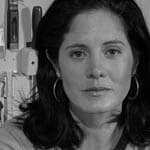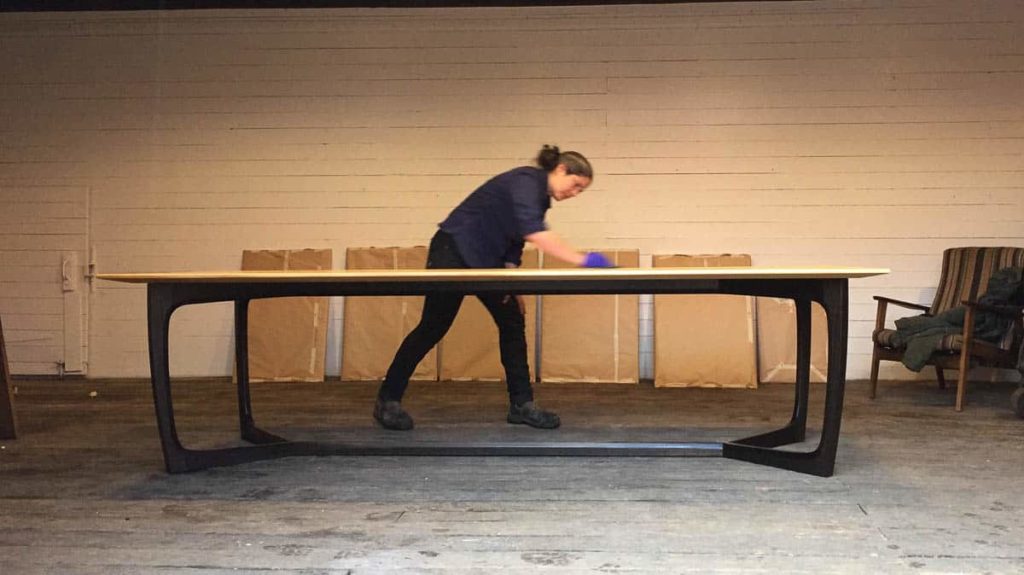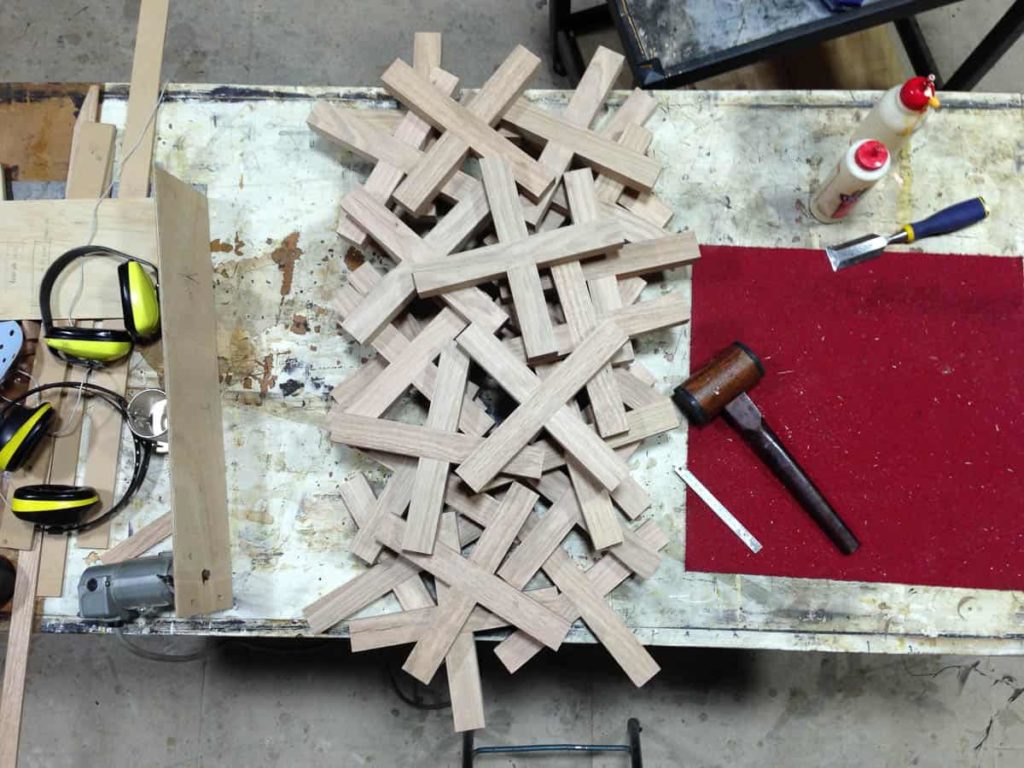- Laura McCusker at work, photo: Peter Howard
- Laura McCusker, JN Cabinet, 2013, photo: Peter Howard
- Laura McCusker, Short Black coffee table, 2018, photo: Peter Whyte Photography
- workshop detail, photo: Peter Howard
- Laura McCusker, Barcode screen, 2003, photo: Peter Whyte Photography
- Laura McCusker, photo: Peter Howard
“Even the common articles made for daily use become endowed with beauty when they are loved.” Soetsu Yanagi
1957. Rio de Janeiro. My mother, aged 15, looks out the window. She’s waiting for a chair. A chair that has been measured, designed and handcrafted in Jacaranda just for her by the local maker down the road. When my grandmother died, this chair was shipped from Brazil to Sydney, then down to Tasmania for my young daughter. Although she shouldn’t, she swings on it the just as her grandmother’s did fifty years earlier.
This is furniture with a story. Furniture made to last. Handcrafted, to be used and loved. In my mind, this is deep sustainability. After all, an item that is made well can be mended and re-made again.
My aim as a designer and maker is that my work will inspire stories such as this one. I design objects that are appealing on different levels; pieces that people will enjoy relating to and using. They need to be beautiful, useful, and perform the task for which they were designed, well. Not just for this season or for this decade; but indefinitely.
I am passionate about combining traditional craftsmanship with contemporary design. The philosophy of Slow Design resonates strongly with me. I seek to infuse my work with a richness that deepens the ways in which people connect with my pieces. As much as possible, I am integral in every step of the process, from design through to manufacture and delivery.
Living in Tasmania, I am acutely aware of the precious resource with which I work. The idea of buying a piece of furniture for a look or as part of a fad promotes the wider problems of our throw-away society. The limited availability of natural resources is an important issue in my design, and so I aim for a timeless aesthetic and ensure longevity through the use of the highest quality materials and traditional joinery techniques.
Slow Design is a branch of the Slow Movement (personally, I think “slow” is a misnomer: better to think of it as thoughtful, considered or deliberate), and as with every branch of the movement, the overarching goal is to promote well being for individuals, society, and the natural environment. Slow Design aims for a holistic approach to designing that takes into consideration material and social factors and both the short and long term impacts of the design.
Fuad-Luke nailed it in 2005 when he wrote: “What is clear is that modernist, organic, post-modern or any other doctrine with recognisable semiotics, is easily subverted in the service of industry and to the glory of consumerism and economic progress. … Corporate ambition, encouraged by the capitalist political doctrine, continues to ensure that inbuilt obsolescence, the touchstone of industrial design, keeps producers producing, consumers consuming and designers designing.” …. the question then becomes, what am I going to do about it?
I have made a conscious decision whenever possible, to produce using local materials for the local market, working with other local practitioners. Invariably this means that my work develops a local flavour and collaborations encourage the vernacular. But more than this, working in this way is about pulling back on the reins and taking time to do things well, do them responsibly, and do them in a way that allows the designer and the end user to derive pleasure from it …or in other words: put some soul into it.
The reason for the resurgence of craft in the last decade seems to me fairly self-evident. Manufacture and design has now become so globalised that cultural influences are fast disappearing with shops on opposite sides of the planet selling more or less the same items, whether it be foods, furniture or footwear. This fact has generated a deep desire for authenticity, and when this is combined with increasing environmental awareness, the purchasing decisions become more weighted according to sustainability and local sourcing.
Craft resides for me in that sweet spot where trade, art and design overlap. Working as a craftsperson is a privilege which allows for the connection between head, heart and hand in the everyday. Functioning holistically is becoming rarer and rarer in contemporary society, where people are more and more compartmentalised into either cerebral or manual work. I am very grateful for the work I am able to do, and the people I am able to do it with and for.
I enjoy including our clients in the design and making process when possible. Instagram has become a very important tool, not only in bringing together communities of makers, but also in including the end user in the development of their piece. I find this inclusive technique creates attachment to the piece even before it exists. It’s like writing a collaborative creation story, seeing progress shots and updates shows all the processes involved, makes the piece “real” and ensures longevity through emotional attachment. I was asked by one happy customer to print and bind the photos I’d taken into an album, documenting the fabrication of his dining table so he could show his two boys. I like to think the pieces I make will always be treasured, irrespective of changing life stages or circumstances. Furniture that will be passed on to the next generation, just like my mum’s chair.
For me, designing and making is an organic process, inseparable from the everyday goings on of my life. Moments of inspiration such as making origami with my children, a barcode on my cereal box, or the light flickering through stands of trees often form the seed of an idea. This is layered upon the cross-cultural influences of my childhood; the knowledge and skills gained through studies in design and fine woodwork; and an intimate knowledge of the materials I work with. As I chat with clients in my workshop and they see their furniture taking shape, these influences and layers are shared, and hopefully, so begin their stories.
Author
 Laura McCusker Furniture was established in 1996, under the flight path, in Sydney’s gritty, industrial inner-west. Since relocating to Hobart in 2003 we have continued to make quality handmade, individually designed pieces tailored to our clients’ specific needs. Now, however, we work next to a babbling brook, surrounded by heirloom fruit trees, in an old apple packing shed. We have been lucky enough to work on projects with MONA, the Tasmanian Museum and Art Gallery and a bunch of other fantastic clients from Tasmania, mainland Australia and beyond.
Laura McCusker Furniture was established in 1996, under the flight path, in Sydney’s gritty, industrial inner-west. Since relocating to Hobart in 2003 we have continued to make quality handmade, individually designed pieces tailored to our clients’ specific needs. Now, however, we work next to a babbling brook, surrounded by heirloom fruit trees, in an old apple packing shed. We have been lucky enough to work on projects with MONA, the Tasmanian Museum and Art Gallery and a bunch of other fantastic clients from Tasmania, mainland Australia and beyond.







